My Internship Shadowing Experience: Nighttime Sea Turtle Walk
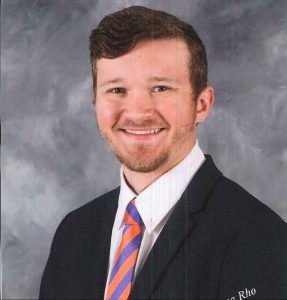
My Background
My name is Sean MacWilliam and I was born and raised in coastal SE Florida. I am currently a senior at the University of Florida studying Forest Resources and Conservation with a specialization in Protected Areas Management. I was informed in November of 2021 that I have received a slot for the University of Florida Institute of Food and Agricultural Science Extension Internship for the 2022 Summer. I have chosen to intern in St. Lucie County as it is close to home, and I have previous knowledge and experiences within the landscape. My summer internship will be under the mentorship of UF/IFAS Extension St. Lucie County extension agents Ken Gioeli (Natural Resources & Environment) and Kate Rotindo (Urban Horticulture). This is my internship shadowing experience on a nighttime sea turtle walk.
During my summer internship in St. Lucie County, I will be shadowing scientists at various organizations. My first shadowing experience was with Dr. Carey Minteer and her team conducting research on biological control of invasive earleaf acacia at the UF/IFAS Indian River Research and Education Center. My next internship shadowing experience was learning about how Florida Atlantic University at Harbor Branch Oceanographic Institute is using native sea vegetables for both human consumption and coastal restoration.
What did I do?
On the evening of Tuesday, June 6th I traveled to Jensen Beach, Florida to go on a sea turtle walk. This event was organized through Ecological Associates Inc., (EAI), who survey roughly 50 miles of Florida’s southeast coastline for nesting sea turtles. Of the seven species found worldwide, five have been documented to nest in Florida. The most common nesting sea turtles found in Florida are the loggerhead (Caretta caretta), green (Chelonia mydas), the leatherback (Dermochelys coriacea). Kemp’s ridley (Lepidochelys kempii), and hawksbill (Eretmochleys imbricata) do nest in Florida, but it is not as common as other species (Duran et al., 2021). The kemp’s ridley is very commonly found along Mexico’s Gulf coast in an area called Rancho Nuevo. The hawksbill primarily nests in the Caribbean.
The preliminary presentation gave an overview of all native species located here in Florida. In addition to sea turtles, the presenters talked about the differences between land tortoises, land turtles, and sea turtles. The Gopher Tortoise, (Gopherus polyphemus), is a land-dwelling species that does not ever go into the water. Unlike sea turtles, this species can completely retract itself into its shell. Sea turtles can only partially retract their head into their shell when in danger, while their flippers cannot retract at all. Land turtles such as the Florida Box Turtle, (Terrapene carolina bauri), are another example of native species that do not live within water. The Florida softshell turtle, (Apalone mutica) is an aquatic species of turtle that has a retractable neck that can expand several inches and reach behind its front legs. When handling any turtle species, make sure to only grab in on the back half of shell to lower chances of being hurt.
EAI documents all the sea turtle nesting sites within their area. This includes documenting how many nests per species were recorded during nesting season. They also do several statistical measures on these nest sites. Since sea turtle nesting season in St. Lucie County runs from March 1 to November 15, this means that there are plenty of late nights and early mornings for the researchers. According to Lauren Maline, a biologist with EAI, in 2021 the research team recorded the following nest site numbers:
- Leatherback
- St. Lucie County – 59
- Martin County –253
- Green
- St. Lucie County – 388
- Martin County – 1,893
- Loggerhead
- St. Lucie County – 2,424
- Martin County – 5,140
This means that in 9.5 months, 285 days, in Martin County alone, there was an average of 18, compared to St. Lucie County at 8.5 loggerhead nests per night. In the same time period for both counties, it was an average of 26.5 nests per night.
When we were informed that a nesting sea turtle was spotted by an EAI staff member, we were given the location to meet at. Once all participants were together at the beach, this was the time to double-check that personal smart devices will not use a camera flash when taking pictures. Flash photography can scare off the nesting turtle and cause false crawls. False crawls are when nesting females’ beaches decide not to nest, this can come from lights on the beaches or human disruption. While walking to our nesting turtle, two more came out of the water. One turtle laid her eggs, while the other was a false crawl.
Sea turtles are still considered threatened or endangered, and there are several reasons why. This includes being caught in massive fishing nets, illegal harvesting of the shells, and destruction of habitats. These turtles are an essential part of our coastal ecology and all injured sea turtles should be reported to proper authorities.
About these turtle walk photos
Ethical sea turtle photography during our turtle walk was conducted under FWC Permit 22-160. Ecological Associates Inc Turtle Watch. Photo credits: Sean MacWilliam, UF/IFAS St. Lucie County Intern. No flash photography was used.
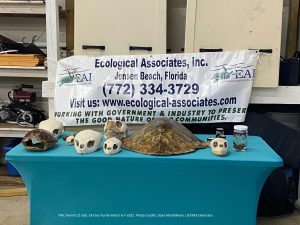
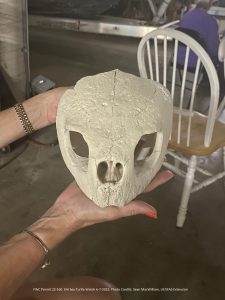
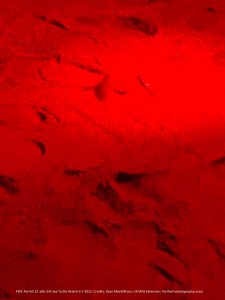

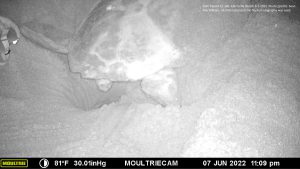
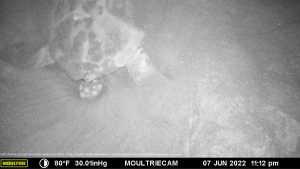
Thank you
A big thank you to all at Ecological Associates Inc., for the opportunity to go on a sea turtle walk.
Additional Links
Ecological Associates – Environmental Consulting Firm (ecological-associates.com)
Works Cited
Duran, Analisa, et al. “A Guide to Nesting Sea Turtles in Florida.” UF|IFAS Extension, University of Florida, 23 Sept. 2021, https://edis.ifas.ufl.edu/.
Maline, Lauren. “2022 Sea Turtle Walk.” Ecological Associate Inc., 2022 Sea Turtle Walk. Ecological Associate Inc., 2022 Sea Turtle Walk, 7 June 2022, Jensen Beach, Florida.
Legal
All federal, state, and county sea turtle laws were followed. FWC Permit 22-160. EAI Turtle Walk 6-7-2022. No flash photography was used.
My Other Internship Blogs
MacWilliam, S., and Gioeli, K. (2022, June 6) Sea vegetables at Harbor Branch Oceanographic. [Blog]. https://blogs.ifas.ufl.edu/stlucieco/2022/06/06/harbor-branch-sea-vegetables/
MacWilliam, S., and Gioeli, K. (2022, June 1). My internship shadowing experience: working with earleaf acacia and a potential biological control method. [Blog]. https://blogs.ifas.ufl.edu/stlucieco/2022/06/01/earleaf-acacia-biological-control/
Posted: June 9, 2022
Source: UF/IFAS Alert – https://blogs.ifas.ufl.edu/



